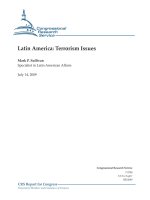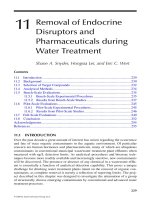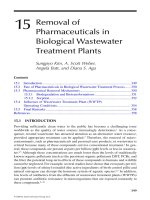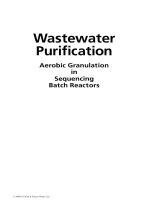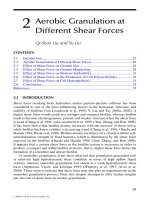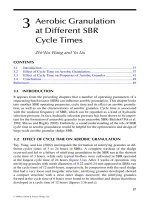Wastewater Purification: Aerobic Granulation in Sequencing Batch Reactors - Chapter 14 doc
Bạn đang xem bản rút gọn của tài liệu. Xem và tải ngay bản đầy đủ của tài liệu tại đây (507.66 KB, 19 trang )
239
14
Influence of Starvation
on Aerobic Granulation
Yu Liu, Zhi-Wu Wang, and Qi-Shan Liu
CONTENTS
14.1 Introduction 239
14.2 Positive Effect of Starvation on Aerobic Granulation 240
14.2.1 Observation of Aerobic Granulation in an SBR 240
14.2.2 Periodic Starvation in the SBR 241
14.2.3 Effect of Periodic Starvation on Cell Surface Hydrophobicity 242
14.3 Inuence of Short Starvation on Aerobic Granules 245
14.3.1 Inuence of Carbon and Nutrients Starvation on
Cell Surface Property 246
14.3.2 Inuence of Carbon and Nutrients Starvation on EPS Content 250
14.3.3 Inuence of Carbon and Nutrients Starvation on Microbial
Activity and Production 250
14.4 Conclusions 255
References 255
14.1 INTRODUCTION
As discussed in the preceding chapters, the unique feature of a sequencing batch
reactor (SBR) over the continuous activated sludge process is its cycle operation,
whichinturnresultsinaperiodicstarvationphaseduringtheoperation.Suchperi-
odical starvation has been thought to be important for aerobic granulation (Tay, Liu,
andLiu2001a).Theresponsesofcellstostarvationhavebeenstudiedintensively.
Nevertheless,controversialresultshavebeenwidelyreportedintheliterature.For
instance, starvation has been thought to induce cell surface hydrophobicity, which
facilitates microbial adhesion and aggregation (Bossier and Verstraete 1996; Y. Liu
et al. 2004); however, the negative effect of starvation on cell surface hydrophobicity
was also reported by Castellanos, Ascencio, and Bashan (2000). Moreover, constant
cell surface hydrophobicity was observed during carbon starvation as well (Staffan
andMalte1984;Sanin2003;Sanin,Sanin,andBryers2003),andsludgeoccula-
tion capacity was found to decrease with prolonged starvation (Rhymes and Smart
1996; Coello Oviedo et al. 2003). In this case, this chapter especially discusses the
potentialroleofstarvationinaerobicgranulation.
53671_C014.indd 239 10/2/07 2:18:33 PM
© 2008 by Taylor & Francis Group, LLC
© 2008 by Taylor & Francis Group, LLC
240 Wastewater Purification
14.2 POSITIVE EFFECT OF STARVATION ON
AEROBIC GRANULATION
Q S.Liu(2003)investigatedtheroleofperiodicstarvationinaerobicgranulation,
andconcludedthatithasapositiveeffectonaerobicgranulationinSBRs,aspre-
sented below.
14.2.1 OBSERVATION OF AEROBIC GRANULATION IN AN SBR
Theseedsludgehadanaveragesizeof0.07mm,andexhibitedatypicalmorphologyof
conventional activated sludge ocs (gure 4.1). On day 23, aerobic granules appeared
intheSBR,withaclear,compactphysicalstructure(gure14.2andgure14.3).
FIGURE 14.1 Morphology of seed sludge. (From Liu, Q S. 2003. Ph.D. thesis, Nanyang
Technological University, Singapore. With permission.)
FIGURE 14.2 Morphology of aerobic granules at day 23 in an SBR. (From Liu, Q S. 2003.
Ph.D.thesis,NanyangTechnologicalUniversity,Singapore.Withpermission.)
53671_C014.indd 240 10/2/07 2:18:34 PM
© 2008 by Taylor & Francis Group, LLC
© 2008 by Taylor & Francis Group, LLC
Influence of Starvation on Aerobic Granulation 241
14.2.2 PERIODIC STARVATIONINTHESBR
Foraerobicgranulation,theSBRisoftenruninamodeoflling,aeration,settling,
and withdrawal of the efuent. Figure 14.4 shows the substrate degradation time at
different operation cycles in an SBR. At cycle 12, or the second day after the startup,
acetate concentration in terms of COD dropped from 1000 mg L
–1
to 50 mg L
–1
within120minutes,whilethetimeperiodforthesameCODremovalwasreducedto
85minutesatcycle36,andfurtherto50minutesatcycle60.Theseresultsindicate
thatthedegradationtimerequiredtoreducesubstrateconcentrationtoaminimum
FIGURE 14.3 Morphologyofaerobicgranulesobservedbyscanningelectronicmicro-
scopy. (From Liu, Q S. 2003. Ph.D. thesis, Nanyang Technological University, Singapore.
With permission.)
Time (min)
0 60 120 180 240
COD (mg L
–1
)
0
200
400
600
800
1000
FIGURE 14.4 The COD concentration at the 12th (D), 36th ($), and 60th ( )cyclesofan
SBR. (From Liu, Q S. 2003. Ph.D. thesis, Nanyang Technological University, Singapore.
With permission.)
53671_C014.indd 241 10/2/07 2:18:35 PM
© 2008 by Taylor & Francis Group, LLC
© 2008 by Taylor & Francis Group, LLC
242 Wastewater Purification
value was shortened markedly over the operation. Thus, for a given cycle length of
4 hours, a starvation phase would exist even at the beginning of the reactor operation
(Q S. Liu 2003).
It appears from gure 12.4 that the aeration period can be divided into two
consecutive phases, a degradation phase, in which external substrate is depleted to
a minimum concentration, followed by an aerobic starvation phase, in which the
externalsubstrateisnolongeravailableformicrobialgrowth.Itwasfoundthatwith
anincreaseinthenumberofcyclesintheSBR,thedegradationtimerequiredtobreak
down the same amount of substrate became shorter (gure 14.4), that is, the starva
-
tiontimeisincreasedwiththenumberofoperationcycles.Buitron,Capdeville,and
Horny(1994)studiedtherelationshipofdegradationtimetoSBRoperationcycles,
andfoundthataftera10-cycleoperation,thedegradationtimewasreducedby80%,
thatis,80%oftheaerationperiodwasinastateofaerobicstarvation.Foraxed
cycletimeof4hours,theaerobicstarvationperiodwasfoundtobe105minutes
atcycle12,140minutesatcycle36,and175minutesatcycle60(Q S.Liu2003).
Figure 14.5 further exhibits the direct relationship between the cycle number and
starvation time observed in the SBR. Similar results were also reported by Buitron,
Capdeville, and Horny (1994). This seems to indicate that there is a periodic aerobic
starvationphaseinthecycleoperationofSBR,butsuchaperiodicstarvationpattern
doesnotexistinthecontinuousactivatedsludgeprocess.
14.2.3 EFFECT OF PERIODIC STARVATION ON CELL SURFACE HYDROPHOBICITY
Figure14.6showschangesincellsurfacehydrophobicityandsubstratedegradation
timeinthecourseoftheoperationofanSBRforaerobicgranulation.Ascanbe
seen, the seed sludge had a surface hydrophobicity of 49%, while the cell surface
hydrophobicitywasincreasedto70%atcycle36,andfurtherto80%atcycle60,and
nally stabilized at 85% after the formation of aerobic granules. The cell surface
Number of SBR Operation Cycles
12 36 60 90 130
Starvation Time (min)
0
30
60
90
120
150
180
FIGURE 14.5 The observed starvation time versus the number of cycles in the SBR. (Data
fromLiu,Q S.2003.Ph.D.thesis,NanyangTechnologicalUniversity,Singapore.)
53671_C014.indd 242 10/2/07 2:18:36 PM
© 2008 by Taylor & Francis Group, LLC
© 2008 by Taylor & Francis Group, LLC
Influence of Starvation on Aerobic Granulation 243
hydrophobicity of aerobic granules was nearly two times higher than that of the
seed sludge. As demonstrated in chapter 9, aerobic granulation is associated with an
increase in cell surface hydrophobicity.
Itcanbeseeningure14.7thatthecellsurfacehydrophobicitywasincreased
from55%to85%whenthestarvationtimewasincreasedfrom105to190minutes.
Apparently, the periodic starvation in the SBR improves the cell surface hydro-
phobicity. However, in the continuous activated sludge reactor, no improvement in
cell surface hydrophobicity was observed in the course of operation, for example, the
cellsurfacehydrophobicityofsludgecultivatedinthecontinuousreactorwassimilar
tothatoftheseedsludgeoverthewholeexperimentalperiod(Q S.Liu2003).
Number of Reactor Operation Cycles
0 12 36 60 90 130
Cell Surface Hydrophobicity (%)
40
50
60
70
80
90
Degradation Time (min)
0
20
40
60
80
100
120
140
FIGURE 14.6 Changes in cell surface hydrophobicity and substrate degradation.
Starvation Time (min)
105 140 175 191 192 194
Hydrophobicity (%)
50
60
70
80
90
FIGURE 14.7 Cell surface hydrophobicity versus starvation time in an SBR. (Data from
Liu,Q S.2003.Ph.D.thesis,NanyangTechnologicalUniversity,Singapore).
53671_C014.indd 243 10/2/07 2:18:38 PM
© 2008 by Taylor & Francis Group, LLC
© 2008 by Taylor & Francis Group, LLC
244 Wastewater Purification
The response of bacteria to starvation has been widely reported (Kjelleberg and
Hermansson 1984; Hantula and Bamford 1991; Bossier and Verstraete 1996). In
asequencingbatchbiolterreactor,DiIaconietal.(2006)foundthatthestarva
-
tiontimeincreasedwiththebedheightaslessandlessamountofsubstratewould
reachdeeperpartsofthelterbed;meanwhilecellsurfacehydrophobicitytended
to increase along the depth of the lter bed (table 14.1). According to such results,
Di Iaconi et al. (2006) concluded that starvation could improve cell surface hydro
-
phobicityandtheeffectofstarvationoncellsurfacehydrophobicitywouldbemore
signicant than that of hydrodynamic shear force.
Kjelleberg and Hermansson
(1984) demonstrated that under starvation condi-
tions, bacteria became more hydrophobic, which in turn facilitated microbial adhe
-
sion and aggregation. In fact, aggregation can be regarded as an effective strategy
of cells against starvation. A similar phenomenon was also observed by Watanabe,
Miyashita,andHarayama(2000),thatis,cellsshowedahighersurfacehydrophobic
-
ity when they were subject to starvation. It is believed that hydrophobic binding has
aprimeimportanceforcellattachment,thatis,ahighercellsurfacehydrophobicity
wouldresultinastrongercell-to-cellinteractionandfurtheradensestructure(see
showingalowersludgevolumeindex(SVI)athighercellsurfacehydrophobicity.
Inaparallelstudy,Q S.Liu(2003)foundthataerobicgranulationfailedinthe
continuous activated sludge reactor, and aerobic granules were only developed in the
SBR. These ndings imply that the periodic starvation-induced hydrophobicity is a
governingfactorinaerobicgranulationintheSBR.
Asshowninchapter9,cellsurfacehydrophobicityplaysacrucialroleinthe
formation of biolm and biogranules. In a thermodynamic sense, increased cell
surface hydrophobicity can result in a lowered surface Gibbs energy, which in turn
favors cell-to-cell interaction. In addition, cells in starved colonies were found to
form connecting brils, which in turn strengthened cell-to-cell interaction and com
-
munication(VaronandChoder2000).Apparently,suchstarvation-inducedchanges
favortheformationofstrongmicrobialaggregates.Starvationhasbeenproposedto
be a trigger in the microbial aggregation process (Bossier and Verstraete 1996). As
discussedearlier,inanSBRmicroorganismsaresubjecttoaperiodicaerobicstar
-
vation.Tay,Liu,andLiu(2001a)thoughtthattheperiodicstarvationpresentinthe
TABLE 14.1
Biomass Hydrophobicity at Different Filter Bed Depths
Bed Depth (cm) Biomass Hydrophobicity (%)
0–10 25
10–20 35
20–30 40
30–40 60
Source: Data from Di Iaconi, C. et al. 2006. Biochem Eng J 30: 152–157.
53671_C014.indd 244 10/2/07 2:18:38 PM
© 2008 by Taylor & Francis Group, LLC
© 2008 by Taylor & Francis Group, LLC
chapter9).Thispointindeedisconrmedbytheresultspresentedingure14.8,
Influence of Starvation on Aerobic Granulation 245
SBRwouldbemoreeffectiveintriggeringchangesinthecellsurface,andfurther
lead to a stronger microbial aggregate.
BasedontheirstudyofaerobicgranulationinSBRs,Li,Kuba,andKusuda(2006)
thoughtthat“aerobicgranulationisinitiatedbystarvationandcooperatedbyshear
forceandanaerobicmetabolism,”andfurtherproposedanEPS-relatedpathwayof
aerobic granulation, as illustrated in gure 14.9. According to the interpretation by Li,
Kuba,andKusuda(2006),inthebeginning,starvationplaysanessentialroleinaerobic
granulation, and subsequently the growth of the aerobic granule provides an anaerobic
microenvironment inside the aerobic granule, which favors anaerobic metabolism of
facultative microorganisms. Furthermore, both starvation and facultative microorgan
-
isms facilitate aerobic granulation. It appears from gure 14.9 that there are two pos
-
siblepathwaysleadingtoaerobicgranulation:(1)step1
n step 3 n step 4 n step 5,
and this process is named starvation-driven granulation; (2) step 2
n step 3 n step 4
n step 5, called anaerobic granulation (Li, Kuba, and Kusuda 2006). So far, no solid
evidence supports the mechanisms of aerobic granulation, as illustrated in gure 14.9,
thus such interpretations of aerobic granulation are subject to further discussion.
Consequently, the real role of starvation in aerobic granulation is still debatable and
different views exist in the present literature.
14.3 INFLUENCE OF SHORT STARVATION ON
AEROBIC GRANULES
Toofferin-depthinsightsintotheroleofstarvationinaerobicgranulation,Z W.
Wangetal.(2006)investigatedtheinuenceofshortstarvationonaerobicgranules
as presented below.
Hydrophobicity (%)
40 50 60 70 80 90
SVI (mL g
–1
)
40
60
80
100
120
140
160
180
200
FIGURE 14.8 Sludge volume index (SVI) versus cell surface hydrophobicity in an SBR. (From
Liu, Q S. 2003. Ph.D. thesis, Nanyang Technological University, Singapore. With permission.)
53671_C014.indd 245 10/2/07 2:18:39 PM
© 2008 by Taylor & Francis Group, LLC
© 2008 by Taylor & Francis Group, LLC
246 Wastewater Purification
14.3.1 INFLUENCE OF CARBON AND NUTRIENTS STARVATION ON
C
ELL SURFACE PROPERTY
Figure 14.10 shows the effects of carbon, nitrogen, phosphorus, and potassium starva-
tiononcellsurfacehydrophobicityofaerobicgranules.Thecellsurfacehydrophobicity
tendedtodecreaseinthecourseoftheN,P,andKstarvationcultures,forexample,
thecellsurfacehydrophobicitydecreasedfromtheinitialvalueof80%toabout60%
after4hoursofNandPstarvation.Meanwhile,nosignicantchangeincellsurface
hydrophobicityofaerobicgranuleswasfoundintheKstarvation,whereascellsur
-
facehydrophobicityexhibitedaslightincreaseby7%inthecourseofCstarvation
culture.ChangesincellsurfacezetapotentialintheC,N,P,andKstarvationbatch
cultureareshowningure14.11.Thecellsurfacezetapotentialofaerobicgranules
undertherespectiveC,N,P,andKstarvationuctuatedaroundacertainvalue,that
is, no signicant changes can be observed under these starvation conditions.
The fundamental principle of charge interaction shows that oppositely charged
objectswillexertanattractiveinuenceuponeachother,while,incontrasttothe
attractiveforcebetweentwoobjectswithoppositecharges,twocellsthatareoflike
chargewillrepeleachother(gure14.12).Itisobviousthatanegativelychargedcell
AB
E
1
2
5
D
C
4
Water
Negative Charge
3
FIGURE 14.9 Effect of EPS on aerobic granulation. (A) Seed sludge with low cell hydro-
phobicity and high negative charge; (B) ocs or granules with low surface negative charge
andhighcellhydrophobicity;(C)aggregatesofocsorgranules;(D)growthofgranule
under given shear condition; (E) a reasonable amount of EPS. 1: Starvation-associated EPS
consumption; 2: facultative microorganisms-associated EPS consumption and production;
3: EPS-caused modications of cell surface properties; 4: aggregation of ocs and growth
of granules; 5: shear force-enhanced granule structure and detachment. (From Li, Z. H.,
Kuba, T., and Kusuda, T. 2006. Enzyme Microb Technol 38:670–674.Withpermission.)
53671_C014.indd 246 10/2/07 2:18:41 PM
© 2008 by Taylor & Francis Group, LLC
© 2008 by Taylor & Francis Group, LLC
Influence of Starvation on Aerobic Granulation 247
willexertarepulsiveforceuponasecondnegativelychargedcell,andthisrepulsive
forcewillpushthetwocellsapart,andsubsequentlypreventmicrobialaggregation.
Itisunderstandablethataweakrepulsiveforcecanbeexpectedatalow
surface charge density, thus reduced surface charge density has been thought to
promote microbial aggregation, which is a key step towards to successful aerobic
granulationinSBRs.Furthermore,cellsurfacehydrophobicityseemstoinversely
Hydrophobicity (%)
68
72
76
80
84
88
92
Hydrophobicity (%)
40
50
60
70
80
90
Hydrophobicity (%)
30
40
50
60
70
80
Time (hours)
012345
Hydrophobicity (%)
50
60
70
80
90
N-starvation
C-starvation
P-starvation
K-starvation
FIGURE 14.10 ChangesincellsurfacehydrophobicityinthecourseoftheC,N,P,
and K starvation batch cultures. (Data from Wang, Z W. et al. 2006. Process Biochem
41: 2373–2378.)
53671_C014.indd 247 10/2/07 2:18:42 PM
© 2008 by Taylor & Francis Group, LLC
© 2008 by Taylor & Francis Group, LLC
248 Wastewater Purification
+
–
Oppositely-charged objects attract
+ +
–
–
Objects with like charges repel
FIGURE 14.12 Illustration of charge interaction.
53671_C014.indd 248 10/2/07 2:18:43 PM
© 2008 by Taylor & Francis Group, LLC
© 2008 by Taylor & Francis Group, LLC
Zeta Potential (mv)
–80
–60
–40
–20
0
C-starvation
Zeta Potential (mv)
–60
–40
–20
0
N-starvation
Zeta Potential (mv)
–60
–40
–20
0
P-starvation
Time (hours)
0 1 2 3 4 5
Zeta Potential (mv)
–60
–40
–20
0
K-starvation
fIGure 14.11 Changes in cell surface zeta potential in the course of the C, N, P, and K star-
vation batch cultures. (Data from Wang, Z W. et al. 2006. Process Biochem 41: 2373–2378.)
Influence of Starvation on Aerobic Granulation 249
depend on the surface charge density, which has been reported in activated sludge
aswellasaerobicgranules(Liaoetal.2001;Li,Kuba,andKusuda2006).Sponza
(2003) investigated physicochemical properties of different activated sludge ocs
understeady-stateconditions,andcorrelatedcellsurfacehydrophobicityinterms
ofcontactangleandsurfacechargedensity(gure14.13).Thesalientpointsshown
ingure14.13areasfollows:
1. The respective mean contact angle of the winery and municipal activated
sludgeocswas7°and9°,whilecontactanglesof37°and42°were
obtained for activated sludge ocs grown on the pulp-paper, textile, and
petrochemical wastewaters. Obviously, those tested activated sludge ocs
exhibited typical hydrophilic or moderately hydrophobic properties, largely
determined by their own culture histories.
2. The activated sludge ocs grown on different types of industrial waste-
waters all carried negative charges on their surfaces. A oc surface with
lower negative charge exhibits a higher surface hydrophobicity, whereas the
morenegativelychargedocsurfacereecthigherhydrophilicity.
It should be recalled here that the contact angle is the angle at which a liquid/
vapor interface meets the solid surface. For instance, on extremely hydrophilic
surfaces, a water droplet will completely spread with an effective contact angle of
0°. This occurs for surfaces that have a large afnity for water. On the contrary, on
manyhydrophilicsurfaces,waterdropletswillexhibitcontactanglesof10°to30°,
whileonhighlyhydrophobicsurfaces,whichareincompatiblewithwater,alarge
contactangleof70°to90°canbeobserved.
Pulp-paper Textile Petro-
chemical
Winery Municipal
Contact Angle (degree)
0
10
20
30
40
50
Surface Charge (meq g
–1
VSS)
–0.7
–0.6
–0.5
–0.4
–0.3
–0.2
–0.1
0.0
FIGURE 14.13 Biomass surface hydrophobicity (gray) and charge of activated sludge ocs
(white) grown on different types of industrial wastewaters. (Data from Sponza, D. T. 2003.
Enzyme Microb Technol 32: 375–385.)
53671_C014.indd 249 10/2/07 2:18:44 PM
© 2008 by Taylor & Francis Group, LLC
© 2008 by Taylor & Francis Group, LLC
250 Wastewater Purification
14.3.2 INFLUENCE OF CARBON AND NUTRIENTS STARVATION ON EPS CONTENT
Extracellularpolysaccharides(PS)arestickymaterialssecretedbycells,andPSare
highly involved in adhesion phenomena, formation of matrix structure, microbial
physiology,andimprovementoflong-termstabilityofgranules(seechapter10).The
PScontentsinaerobicgranulesbeforeandafterC,N,P,andKstarvationweredeter
-
mined(Z.P.Wangetal.2006).AreductioninthePScontentwasobservedinall
fourcases(gure14.4),forexamplethePScontentofaerobicgranuleswasreduced
by15%after4-hoursofNstarvation,30%after4hoursofPstarvation,whilethe
respective PS content was substantially reduced by 53% and 65%, respectively, after
4hoursofCandKstarvation.TheseresultsimplythattheCandKstarvationhave
themostprofoundnegativeeffectonthePScontentinaerobicgranules.Inaddition,
Z.P.Wang,ZPetal.(2006)alsoreportedthatextracellularpolymericsubstances
(EPS)wereproducedmainlyintheexponentialphase,andservedascarbonand
energy sources in the starvation phase during the granulation process, and they
thoughtthatsuchafunctionofPScouldregulatemicrobialgrowthintheinterior
andexteriorofgranulesandhelpmaintaintheintegrityofaerobicgranules.
14.3.3 INFLUENCE OF CARBON AND NUTRIENTS STARVATION ON
M
ICROBIAL ACTIVITY AND PRODUCTION
after the 4-hour C, N, P, and K starvation. The SOURs of aerobic granules under the
C,N,andPstarvationconditionsdecreasedmarkedly,whereasanincreaseinthe
SOUR after K starvation was observed. Furthermore, it appears from gure 14.16
thatundertheCandKstarvationconditions,thegrowthofaerobicgranuleswas
seriously suppressed. This may be due to the fact that carbon and potassium are two
essential elements that actively participate in the energy metabolism of cells.
CNPK
PS Changes After Starvations (%)
–70
–60
–50
–40
–30
–20
FIGURE 14.14 ChangesinPSasaresultofC,N,P,andKstarvation.(Datafrom
Wang,Z W.etal.2006.Process Biochem 41: 2373–2378.)
53671_C014.indd 250 10/2/07 2:18:45 PM
© 2008 by Taylor & Francis Group, LLC
© 2008 by Taylor & Francis Group, LLC
Figure14.15comparesthespecicoxygenuptakerate(SOUR)valuesbeforeand
Influence of Starvation on Aerobic Granulation 251
As discussed earlier, Tay, Liu, and Liu (2001a) thought that periodic starvation
observed in SBRs would induce cell surface hydrophobicity which in turn facilitates
aerobicgranulationintheSBR.Itappearsfromgure14.10,however,thatthecell
surfacehydrophobicityofaerobicgranulessubjectedtoNandPstarvationshowsa
decreasing trend, while change in the cell surface hydrophobicity of the K-starved
aerobicgranulesisinsignicantandonlytheC-starvedaerobicgranulesdemonstrate
a slight increase in cell surface hydrophobicity. In fact, the N and P starvations have
often been found to decrease microbial surface hydrophobicity (Bura et al. 1998;
ChenandStrevett2003;Saninetal.2003).RegardingtheCstarvation,inconsistent
resultscanbefoundintheliterature,forexample,ChenandStrevett(2003)reported
apositiveeffectofCstarvationoncellsurfacehydrophobicity,whereasSaninetal.
CNPK
SOUR (mg O
2
g
–1
VSS h
–1
)
20
40
60
80
100
120
140
FIGURE 14.15 ChangesinSOURbefore(D)andafter($)C,N,P,andKstarvation.(Data
fromWang,Z W.etal.2006.
Process Biochem 41: 2373–2378.)
CNPK
Biomass Concentration (g VSS L
–1
)
0.10
0.15
0.20
0.25
0.30
0.35
0.40
0.45
FIGURE 14.16 Changes in biomass concentration before (D)andafter($)C,N,P,and
Kstarvation.(DatafromWang,Z W.etal.2006.Process Biochem 41: 2373–2378.)
53671_C014.indd 251 10/2/07 2:18:47 PM
© 2008 by Taylor & Francis Group, LLC
© 2008 by Taylor & Francis Group, LLC
252 Wastewater Purification
(2003)foundnoeffectofCstarvationoncellsurfacehydrophobicity.Castellanos,
Ascencio,andBashan(2000)evenobservedtheadverseeffectofCstarvationoncell
surfacehydrophobicity.Similartogure14.14,ithasbeenshowninchapter10thata
considerable amount of hydrophilic EPS located in the granule core is biodegradable
to compensate for the shortage of energy source under the C starvation condition,
whichsubsequentlyresultsinahollowgranulestructure(Z W.Wang,Liu,andTay
2005).Infact,gure14.10indicatesthatthereisnoapparentpositiveeffectofthe
shorttermC,N,P,andKstarvationoncellsurfacehydrophobicity.
Thecellsurfacezetapotentialofmicroorganismsreectsthechargedensity
ofthecellsurface.Aerobicgranulationwasfoundtobeassociatedwithadecrease
inthenegativechargedensityofthecellsurface(Li,Kuba,andKusuda2006).As
-
tive charge on their surfaces. Compared to the fresh aerobic granules, no signicant
changesinthesurfacechargeswereobservedinaerobicgranulesafterthe4-hour
starvation. It was thought that cell surface hydrophobicity and surface charge are
closely related to the types of proteins located on the outer membrane of the cell,
while changes in outer membrane protein proles have been commonly reported
during starvation for nitrogen, phosphorus, and potassium, for example starvation
of
Escherichia coli for potassium and phosphate ions leads to a reversible increase
in the rate of protein degradation and an inhibition of ribonucleic acid synthesis
(Nystrom, Olsson, and Kjelleberg 1992; Kragelund and Nybroe 1994). By analyzing
elemental composition of aerobic granules, Y. Liu, Yang, and Tay (2003) found that
cellsurfacehydrophobicitywascloselycorrelatedtocellO/Cratio,thatis,ahigh
cellO/Cratioresultedinalowcellsurfacehydrophobicity(gure14.17).Itseems
reasonabletoconsiderthatthecellO/Cratio,toalargeextent,isdeterminedby
membrane surface proteins.
Cell O/C Ratio (mol mol
–1
)
0.623 0.641 0.685 0.690
Cell Surface Hydrophobicity (%)
70
75
80
85
90
FIGURE 14.17 Effect of cell O/C ratio on cell surface hydrophobicity. (Data from Liu, Y.,
Yang,S.F.,andTay,J.H.2003.Appl Microbiol Biotechnol 61: 556 –561.)
53671_C014.indd 252 10/2/07 2:18:48 PM
© 2008 by Taylor & Francis Group, LLC
© 2008 by Taylor & Francis Group, LLC
canbeseeningure14.11,thefreshandstarvedaerobicgranulesbothcarrynega
Influence of Starvation on Aerobic Granulation 253
decreased slightly in the N- and P-starved aerobic granules, while about 53% and 65%
ofPSreductionwasobservedinaerobicgranulesdeprivedofcarbonandpotassium,
respectively. These results indicate that under the C- and K-starvation conditions,
aerobicgranulesprefertometabolizetheirPSinordertoprovideenergyformain
-
taining basic functions of the living cells. This phenomenon has been observed
in other cultures under C-starvation conditions (Patel and Gerson 1974; Boyd and
Chakrabarty 1994; Ruijssenaars, Stingele, and Hartmans 2000; Zhang and Bishop
2003;Z W.Wang,Liu,andTay2005).Itisreasonabletoconsiderthatmicroorgan
-
ismwouldbyallmeansmakeuseofanypotentialcarbonsourcetocompensatefor
the substrate shortage. Moreover, evidence shows that the disintegration of aerobic
granules was coupled with a sharp decrease in the PS content in aerobic granules
(Tay,Liu,andLiu2001b),thatis,thestabilityofaerobicgranulesistightlyassociated
withthePSofaerobicgranuleswhichmayserveasmatrixmaterialstostrengthen
the spatial structure of aerobic granules. One important engineering implication of
gure 14.14 is that when aerobic granules are subject to substrate and nutrient starva
-
tions,especiallyCandKstarvation,thereducedcontentofPSweakensthespatial
structure and the stability of aerobic granules. This in turn results in instability of
aerobic granular sludge. In fact, potassium deciency is commonly found in indus
-
trial wastewater (Murthy and Novak 1998).
Similartogures14.15and14.16,Hueting,deLange,andTempest(1979)also
observed a progressive increase in the respiration rate of cells, with a corresponding
fall in the biomass production under K limitation. Konings and Veldkamp (1980)
suggested that microorganisms had to increase the proton motive force to main
-
tain the internal concentration constant of the limited essential cation, such as K
+
,
andsucharesponsewouldleadtoanincreasedrateofdissimilationoftheenergy
source, as shown in gures 14.15 and 14.16. Neijssel and Tempest (1979) further
foundthattherewasalinearrelationshipbetweenthespecicrateofoxygenuptake
by K-limited cells and the electrochemical potential of the K gradient.
Increased biomass production was observed under the N- and P-starved cultures
ofaerobicgranules(gure14.16).Theincreasedcellmassduringstarvationfor
nitrogenandphosphorushasbeenthoughttobeduetotheaccumulationofstorage
compounds (Kragelund and Nybroe 1994), while Sidat, Bux, and Kasan (1999)
also found that under aerobic conditions, microorganisms can store polyphosphate
intracellularly, which serves as phosphorus and energy sources during phosphorus
starvation. According to the traditional activated sludge theory (Droste 1997), nitro
-
genandphosphorusareessentiallyrequiredforbiosynthesisofbiomassinaratioof
COD:N:Pof100:5:1.Inordertomaintainbalancedmetabolism,cellsneedtocoordi
-
nate the assimilation of nitrogen with the assimilation of carbon and other aspects of
metabolism. For aerobic granules deprived of nitrogen, hydrolysis of proteins is one
way that can provide nitrogen for microbial growth and maintenance. In fact, nitro
-
genreleasedfromhydrolysisofproteinshasbeenreported(St.JohnandGoldberg
1980;Nystrom,Olsson,andKjellegerg1992;KragelundandNybroe1994).Asa
result of the protein hydrolysis, the SOUR of the N-starved aerobic granules was
reduced by 70% as compared to the fresh aerobic granules (gure 14.15). Thus, it
seems reasonable to consider that the biomass lost in the C-starvation condition
53671_C014.indd 253 10/2/07 2:18:48 PM
© 2008 by Taylor & Francis Group, LLC
© 2008 by Taylor & Francis Group, LLC
Ascanbeseeningure14.14,thecontentofextracellularpolysaccharides
254 Wastewater Purification
(gure14.16)canbeattributedtotheendogenousdecaycausedbytheelectrondonor
limitation as well as the reduction of PS.
Asdiscussedearlier,C,N,P,andKstarvationdidnotshowpositiveeffectson
the stability of aerobic granules. A collective substrate and nutrients starvation test
was further conducted to look into the collective effects of those limitations together
onaerobicgranules(Z W.Wangetal.2006).Thechangesofgranulepropertiesin
termsofPS,SOUR,volatilesolids(VS),hydrophobicity,andSVIasaresultofthis
collective starvation are presented in gure 14.18. It can be seen that PS, SOUR,
and VS tended to decrease, while hydrophobicity and SVI seemed to increase in
response to the collective starvation of aerobic granules. According to Z W. Wang,
Liu, and Tay (2005), the PS reduction shown in gure 14.18 should be due mainly
to the biodegradation of the hydrophilic PS, which in turn leads to the increased
cell surface hydrophobicity. The increased SVI shown in gure 14.18 implies that
this collective starvation results in poor settleability and less compact structure of
aerobic granules. The markedly reduced SOUR would be the result of the collective
limitation of substrate and nutrients.
Bulk liquid turbidity was also measured in the course of the collective starvation
(gure14.19).Itwasfoundthatthebulkliquidbecamemoreandmoreturbidwiththe
increase in the starvation time. This may indicate a bacterial detachment from aerobic
granules in response to the collective starvation. In fact, a similar phenomenon was
alsofoundinthebiolmprocessundersubstrate-andnutrient-decientconditions
(SawyerandHermanowicz1998;Huntetal.2004).
Thepotentialnegativeeffectsofstarvationonthestabilityandactivityofaerobic
granules has been demonstrated. It should be stressed that the genetic regulation of
theresponsetostarvationshouldbeunderstoodinthenearfuture,andhowstarvation
inuencesthecellsurfaceofaerobicgranulesisstillasubjectoffuturediscussion.
EPS SOUR VSS HP SVI
Starvation Caused Changes (%)
–60
–40
–20
0
20
40
FIGURE 14.18 ChangesinEPS,SOUR,VSS,hydrophobicity(HP),andSVIinresponse
to collective substrate and nutrients starvation. (Data from Wang, Z W. et al. 2006. Process
Biochem 41: 2373–2378.)
53671_C014.indd 254 10/2/07 2:18:49 PM
© 2008 by Taylor & Francis Group, LLC
© 2008 by Taylor & Francis Group, LLC
Influence of Starvation on Aerobic Granulation 255
14.4 CONCLUSIONS
A periodic aerobic starvation phase exists in SBRs, though different views can
befoundwithregardtotheroleofstarvationinaerobicgranulation.Someresults
showedthatstarvationisessentialinaerobicgranulation,andcanserveasatrigger
for microbial aggregation. However, it appears that aerobic C, P, N, and K starvation
canalterthesurfacepropertiesofaerobicgranulesandcausenegativeeffectson
the stability and activity of aerobic granules. Therefore, discussion on starvation in
aerobic granular sludge SBRs will continue and more in-depth research is needed to
clarify its role in aerobic granulation.
REFERENCES
Bossier, P. and Verstraete, W. 1996. Triggers for microbial aggregation in activated sludge?
Appl Microbiol Biotechnol 45: 1–6.
Boyd,A.andChakrabarty,A.M.1994.RoleofalginatelyaseincelldetachmentofPseudo
-
monas aeruginosa.
Appl Environ Microbiol 60: 2355–2359.
Buitron,G.,Capdeville,B.,andHorny,P.1994.Improvementandcontrolofthemicrobial
activity of a mixed population for degradation of xenobiotic compounds.
Water Sci
Technol 29: 317–326.
Bura, R., Cheung, M., Liao, B., Finlayson, J., Lee, B. C., Droppo, I. G., Leppard, G. G., and
Liss, S. N. 1998. Composition of extracellular polymeric substances in the activated
sludge oc matrix.
Water Sci Technol 37: 325–333.
Castellanos,T.,Ascencio,F.,andBashan,Y.2000.Starvation-inducedchangesinthecell
surface of Azospirillum lipoferum.
FEMS Microbiol Ecol 33: 1–9.
Chen,G.andStrevett,K.A.(2003)ImpactofcarbonandnitrogenconditionsonE.coli
surface thermodynamics.
Colloids and Surfaces B: Biointerfaces 28: 135–146.
CoelloOviedo,M.D.,Lopez-Ramirez,J.A.,SalesMarquez,D.,andQuirogaAlonso,J.M.
2003. Evolution of an activated sludge system under starvation conditions. Chem Eng J
94: 139–146.
Time (hours)
01234
Turbidity (NTU)
2.0
2.5
3.0
3.5
4.0
4.5
5.0
FIGURE 14.19 Changesofbulkliquidturbidityinthecourseofcollectivesubstrateand
nutrientsstarvation.(DatafromWang,Z W.etal.2006.Process Biochem 41: 2373–2378.)
53671_C014.indd 255 10/2/07 2:18:50 PM
© 2008 by Taylor & Francis Group, LLC
© 2008 by Taylor & Francis Group, LLC
256 Wastewater Purification
Di Iaconi, C., Ramadori, R., Lopez, A., and Passino, R. 2006. Inuence of hydrodynamic
shearforcesonpropertiesofgranularbiomassinasequencingbatchbiolterreactor.
Biochem Eng J 30: 152–157.
Droste, R. L. 1997.
Theory and practice of water and wastewater treatment.NewYork:John
Wiley&Sons.
Hantula, J. and Bamford, D. H. 1991. The efciency of the protein dependent occulation of
Flavobacteriumsp.issensitivetothecompositionofgrowthmedium.
Appl Microbiol
Biotechnol 36: 100–104.
Hueting,S.,deLange,T.,andTempest,D.W.1979.Energyrequirementformaintenanceof
the transmembrane potassium gradient in Klebsiella aerogenes NCTC 418: A continuous
culture study.
Arch Microbiol 123: 183–188.
Hunt,S.M.,Werner,E.M.,Huang,B.C.,Hamilton,M.A.,andStewart,P.S.2004.Hypothesis
for the role of nutrient starvation in biolm detachment.
Appl Environ Microbiol 70:
7418–7425.
Kjelleberg, S. and Hermansson, M. 1984. Starvation-induced effects on bacterial surface
characteristics.
Appl Environ Microbiol 48: 497–503.
Konings, W. N. and Veldkamp, H. 1980. Phenotypic responses to environmental change.
InEllwood,D.C.,Hedger,J.N.,Latham,M.J.,Lynch,J.M.,andSlater,J.M.eds.
Contemporary microbial ecology. London: Academic Press, 161–191.
Kragelund, L. and Nybroe, O. 1994. Culturability and expression of outer membrane proteins
during carbon, nitrogen, or phosphorus starvation of Pseudomonas uorescens DF57
and Pseudomonas putida DF14.
Appl Environ Microbiol 60: 2944–2948.
Li,Z.H.,Kuba,T.,andKusuda,T.2006.Theinuenceofstarvationphaseontheproperties
andthedevelopmentofaerobicgranules.
Enzyme Microb Technol 38: 670–674.
Liao,B.Q.,Allen,D.G.,Droppo,I.G.,Leppard,G.G.,andLiss,S.N.2001.Surfaceproperties
of sludge and their role in bioocculation and settleability.
Water Res 35: 339–350.
Liu, Q S. (2003) Aerobic granulation in a sequencing batch reactor. Ph.D. thesis, Nanyang
Technological University, Singapore.
Liu,Y.,Yang,S.F.,andTay,J.H.2003.Elementalcompositionsandcharacteristicsof
aerobic granules cultivated at different substrate N/C ratios. Appl Microbiol Biotechnol
61: 556–561.
Liu, Y., Yang, S. F., Tay, J. H., Liu, Q S., Qin, L., and Li, Y. 2004. Cell hydrophobicity is a
triggering force of biogranulation.
Enzyme Microb Technol 34: 371–379.
Murthy, S. N. and Novak, J. T. 1998. Effects of potassium ion on sludge settling, dewatering
and efuent properties.
Water Sci Technol 37: 317–324.
Neijssel, O. M. and Tempest, D. W. 1979. The physiology of metabolite over-production.
Symp Soc Gen Microbiol 29: 53–82.
Nystrom,T.,Olsson,R.,andKjelleberg,S.1992.Survival,stressresistance,andalterations
inproteinexpressioninthemarineVibriosp.strainS14duringstarvationfordifferent
individual nutrients.
Appl Environ Microbiol 58: 55–65.
Patel, J. J. and Gerson, T. 1974. Formation and utilization of carbon reserves by Rhizobium.
Arch Microbiol 101: 211–220.
Rhymes,M.R.andSmart,K.A.1996.Effectofstarvationontheocculationofaleandlager
brewing yeasts.
J Am Soc Brew Chem 54: 50–56.
Ruijssenaars, H. J., Stingele, F., and Hartmans, S. 2000. Biodegradability of food-associated
extracellular polysaccharides.
Curr Microbiol 40: 194–199.
Sanin,S.L.2003.Effectofstarvationonresuscitationandthesurfacecharacteristicsof
bacteria.
J Environ Sci Heal A 38: 1517–1528.
Sanin,S.L.,Sanin,F.D.,andBryers,J.D.2003.Effectofstarvationontheadhesiveproperties
of xenobiotic degrading bacteria.
Process Biochem 38: 909–914.
Sawyer,L.K.andHermanowicz,S.W.1998.Detachmentofbiolmbacteriaduetovariations
in nutrient supply.
Water Sci Technol 37: 211–214.
53671_C014.indd 256 10/2/07 2:18:51 PM
© 2008 by Taylor & Francis Group, LLC
© 2008 by Taylor & Francis Group, LLC
Influence of Starvation on Aerobic Granulation 257
Sidat,M.,Bux,F.,andKasan,H.C.1999.Polyphosphateaccumulationbybacteriaisolated
from activated sludge.
Water SA 25: 175–179.
Sponza,D.T.2003.Investigationofextracellularpolymersubstances(EPS)andphysico
-
chemical properties of different activated sludge ocs under steady-state conditions.
Enzyme Microb Technol 32: 375–385.
Staffan, K. and Malte, H. 1984. Starvation-induced effects on bacterial surface characteris
-
tics.
Appl Environ Microbiol 48: 497–503.
St.John,A.C.andGoldberg,A.L.1980.Effectsofstarvationforpotassiumandother
inorganic ions on protein degradation and ribonucleic acid synthesis in Escherichia
coli.
J Bacteriol 143: 1223–1233.
Tay,J.H.,Liu,Q S.,andLiu,Y.2001a.Microscopicobservationofaerobicgranulationin
sequential aerobic sludge blanket reactor.
J Appl Microbiol 91: 168–175.
Tay,J.H.,Liu,Q S.,andLiu,Y.2001b.Theroleofcellularpolysaccharidesintheformation
and stability of aerobic granules.
Lett Appl Microbiol 33: 222–226.
Varon, M. and Choder, M. 2000. Organization and cell-cell interaction in starved Saccharo
-
myces cerevisiae colonies.
J Bacteriol 182: 3877–3880.
Wang,Z.P.,Liu,L.,Yao,J.,andCai,W.2006.Effectsofextracellularpolymericsubstances
on aerobic granulation in sequencing batch reactors.
Chemosphere 63: 1728–1735.
Wang,Z W.,Liu,Y.,andTay,J H.2005.DistributionofEPSandcellsurfacehydrophobicity
in aerobic granules.
Appl Microbiol Biotechnol 69: 469–473.
Wang,Z W.,Li,Y.,Zhou,J.Q.,andLiu,Y.2006.Theinuenceofshort-termstarvationon
aerobic granules.
Process Biochem 41: 2373–2378.
Watanabe, K., Miyashita, M., and Harayama, S. 2000. Starvation improves survival of
bacteria introduced into activated sludge.
Appl Environ Microbiol 66: 3905–3910.
Zhang,X.Q.andBishop,P.L.2003.Biodegradabilityofbiolmextracellularpolymeric
substances.
Chemosphere 50: 63–69.
53671_C014.indd 257 10/2/07 2:18:51 PM
© 2008 by Taylor & Francis Group, LLC
© 2008 by Taylor & Francis Group, LLC
